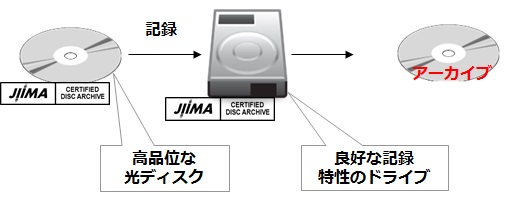Certification Scheme of Optical Disk Products for Archiving
Introduction
The need to digitize reference resources for long-term preservation is found not only among libraries, museums and public archives but also among business enterprises. In the manufacturing industry, for example, there is the demand for the long-term preservation of invaluable assets such as design data and quality data.
In light of the issues over how precious assets can be preserved with stability amid the rapid advances in digital information technology, the optical disc format, which has been assured compatibility with standardization under ISO and JIS, has been developed based on private-sector technology. We anticipate that a good supply of optical disk drives will be available for a long period of time.
The Certification Scheme of Optical Disk Products for Archiving provides certification by the Japan Image and Information Management Association (JIIMA) regarding the quality of the optical disk drive to be used for archiving. The use of certified products is expected to assure long-term preservation via high-quality optical disks.
Objective
Generally speaking, the optical disk is an electronic recording medium characterized by its ability to record and preserve information over a long period of time as compared to other electronic recording media. When used for archiving (the preservation of electronic data for more than 30 years), the data must be recorded on a highly reliable disk using a highly reliable method.
JIIMA examines the combination of the optical disk/drive and issues certification to those combinations that assure satisfactory quality.
Certification Scheme

The quality of recording with a certified combination of disk and drive must satisfy JIS Z 6017 (Document management - Long-term preservation for electronic imaging documents) standards and assure that the estimated life of the disk will be 30 years or more, verified with a life test conducted in compliance with ISO/IEC 16963.
Certified Products


Products that have been deemed certified optical disk products are approved to bear the logo as shown above.
Although optical disks and drives are sold separately, the quality appropriate for archiving can be achieved only through designated combinations of products. (Refer to Q2 of the Q&A.)
Certified products are those that have earned certification that they possess quality sufficient for archiving at the point of factory shipment. Considering that degradation can depend on how the product is handled until it is used and the storage environment, certification does not necessarily guarantee that the written data will maintain adequate quality.
Handling and Preservation of Optical Disk Products for Archiving
For long-term storage of invaluable data, safety cannot be assured with the use of optical disk products for archiving alone, but also with the use of the creation and preservation methods in compliance with JIS Z 6017. They are as follows.
- Create original and duplicate sets of recording media, with one set stored at a remote location that will not be affected by the same natural disaster striking the storage location.
- To handle the recording medium, refer to "Caution when handling optical disks" created by the Japan Recording-Media Industries Association (JRIA).
- The specifications of the storage environment for optical disks are shown below. Storage should preferably in an environment equipped with fire prevention and seismic-resistant facilities for long-term storage.
- Long-term storage environment: Storage in a long-term archive or repository is appropriate for storing optical disks over a long period of time.
- Office environment: Storage in an office environment is possible with data migration to new media.
| Storage Conditions | Long-Term Storage Environment | Office Environment |
| Temperature (°C) | 10 - 25 | 5 - 30 |
| Humidity (%) | 40 - 60 | 15 - 80 |
| Dust | Environment with little dust. | Environment with little dust. |
| Repository Structure | Fire-resistant structure that can be kept under lock and key. Away from direct sunlight and dew condensation. | Can be kept under lock and key. Away from direct sunlight and dew condensation. |
| Others | Absence of toxic gas. | Absence of toxic gas. |
Storage environment for optical disks: Please see Table 3, JIS Z 6017:2013.
Please see below for details.
Handling and Preservation of Optical Disk Products for Archiving
Certification Based on JIS X 6257
The Certification Scheme of Optical Disk Products for Archiving was introduced in 2014 as JIIMA's first JIS-compliant certification scheme based on JIIMA’s Archiving Guidelines Using Optical Disks for Long-Term Storage and JIS Z 6017: Data management ? Long-term preservation for electronic imaging documents.
The scheme was reinforced further and promoted with the subsequent establishment of JIS X 6257: Quality discrimination method of optical disks and operating method of storage system for long-term data preservation.
With the explosive proliferation of digital information since then, demand has grown rapidly from digital information "recording" to "archive preservation," directing interest to optical disk products for archiving, thus enabling off-line (energy-saving) data archiving.
For the wider dissemination of recording-type optical disks for scanned disk and digital data preservation, as well as to upgrade the reliability of recording quality, studies have been conducted on the introduction of a defect management function that enables recorded data substitution processing if the recording is found to be incomplete due to disk failure, etc. (hereinafter called a DM optical disk).
The DM optical disk was adopted as a product for archive preservation as part of the FY2020 program for the acquisition and dissemination of energy efficiency-related standards of the Ministry of Economy, Trade and Industry (METI). Use of the function was added to JIS X 6257 as mentioned earlier, resulting in revision of the standard in FY2022.
With these developments, the Certification Scheme of Optical Disk Products for Archiving based on the revised JIS X 6257 was added to other JIIMA certification schemes and took effect on November 21, 2022.
